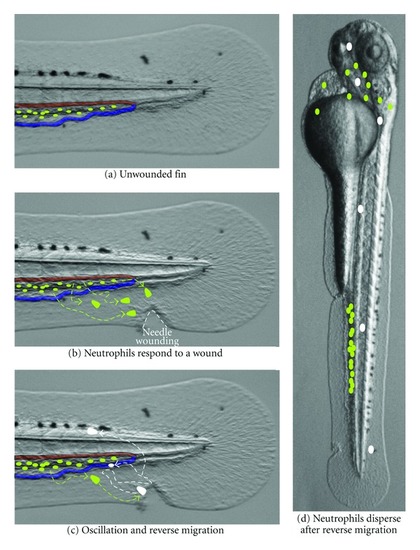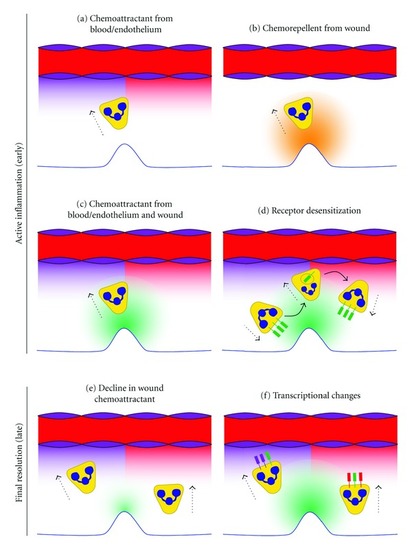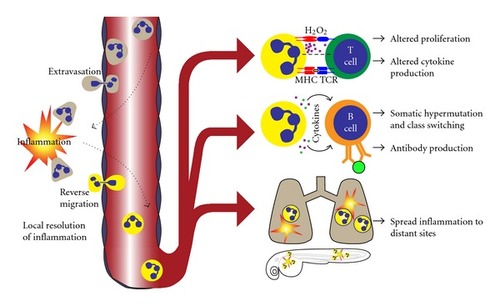- Title
-
Neutrophil Reverse Migration Becomes Transparent with Zebrafish
- Authors
- Starnes, T.W., and Huttenlocher, A.
- Source
- Full text @ Adv. Hematol.
|
Neutrophil reverse migration in zebrafish larvae. This diagram illustrates the behavior of neutrophils undergoing reverse migration over an image of a 3-day postfertilization zebrafish larva that was PTU-treated to prevent pigmentation. (a) In unwounded larva, neutrophils (green ovals) are present in the caudal hematopoietic tissue (CHT), which is situated between the caudal artery (red shading) and the caudal vein (blue shading). (b) In response to a wound, neutrophils are mobilized from the CHT, and they migrate through the tissue towards a wound. (c) The green to white color change represents the ability to photoconvert individual neutrophils that reach a wound. Neutrophils often migrate between the wound and the vasculature multiple times before finally departing. Neutrophils have been observed performing reverse migration by entering the vasculature and by migrating through tissues in zebrafish larvae. (d) Reverse migrated neutrophils (white) are found dispersed throughout the body without an obvious tissue preference 2 days after leaving wounds. |
|
Proposed mechanisms for reversed migration. This diagram illustrates how chemoattractant gradients from the blood (red), endothelium (purple), and wound (green) or chemorepellent gradients (orange) may influence reverse migration. The color of a chemoattractant receptor matches the gradient to which it responds. (a)–(d) Reverse migration in the early wound response. (a) Demonstration of neutrophil reverse migration towards blood or endothelium-derived chemoattractants. (b) Reverse migration of a neutrophil away from a wound-derived chemorepellent. There could be competition between wound-derived chemoattractants (not shown) and chemorepellents promoting reverse migration, or neutrophils may perform fugetaxis from areas of high chemoattractant concentration. (c) Oscillatory behavior of neutrophils suggests competing gradients of chemoattractants may exist between the wound and vasculature. (d) Receptor desensitization, via internalization or other mechanisms, may allow neutrophils to oscillate between the wound and the vasculature while others are still actively responding to the wound. (e)–(f) Mechanisms that promote resolution of neutrophil-mediated inflammation at wounds. (e) During the healing phase, wounded tissue may gradually produce less neutrophil chemoattractant, shifting the balance to favor reverse migration. (f) Neutrophils that responded to a wound may initiate transcriptional changes favoring reverse migration from the wound. Potential changes include altered expression or sensitivity of chemoattractant receptors. |
|
Potential functions of reverse migrated neutrophils. On the left side of the illustration, neutrophils (tan) are responding to an extravascular inflammatory stimulus. After responding to the stimulus, neutrophils perform reverse migration (yellow) and enter the vasculature. This process has been suggested as a mechanism to resolve inflammation at the local level. We are proposing the following as potential functions of reverse migrated neutrophils. Neutrophils may modulate T-cell proliferation and cytokine production in an antigen-independent or-dependent manner. Integrin-mediated neutrophil-T cell contact, hydrogen peroxide, and T cell receptor (TCR) signaling have demonstrated importance in neutrophil-mediated regulation of T cell function. Neutrophils may promote antibody diversification, class switching, and production by splenic B cells through the secretion of cytokines. Reverse migrated neutrophils may travel to distant tissues and induce additional inflammation. Reverse-migrated neutrophils were implicated in inducing pulmonary inflammation in mice. |



